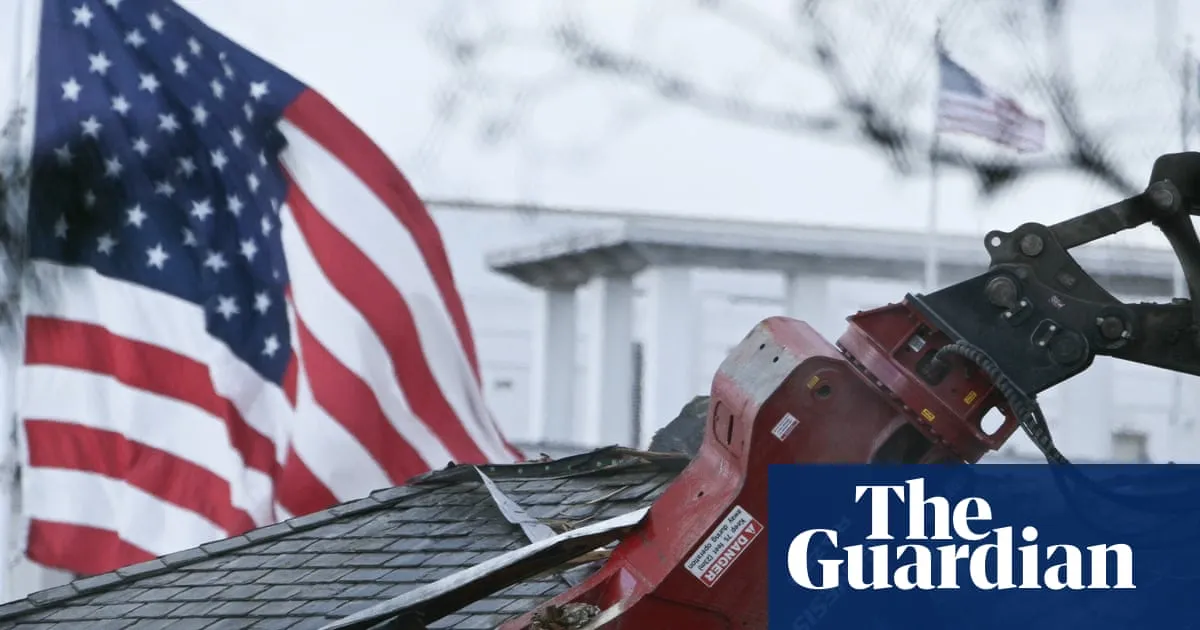
At the 2011 White House Correspondents’ Association dinner, former President Barack Obama delivered a memorable roast aimed at Donald Trump. The highlight of this comedic moment was a satirical cartoon that depicted what the White House might resemble if Trump were ever to assume the presidency. The illustration featured the name “Trump” in bold, capital letters, accompanied by “the White House” in a flashy purple cursive. Additional text, including “hotel casino golf course” and “presidential suite,” painted a picture of extravagance with gold pillars, a massive crystal chandelier, and two scantily-clad women at reception.
Fast forward fourteen years, and Obama’s humorous vision increasingly seems prophetic. Donald Trump, having been elected twice and intent on expanding the powers of the presidency, has left his extravagant mark on the White House. Recently, he took a bold step by dispatching a demolition crew to tear down the facade of the East Wing, with plans to construct a $250 million ballroom. The scene of broken masonry, rubble, and exposed steel at America's most iconic residence drew comparisons to a disaster film, resonating even with those who have grown accustomed to Trump’s controversial actions.
The demolition has sparked outrage among former White House officials and presidential historians. Elaine Kamarck, who served in the White House during the 1990s, expressed her dismay, stating, “It’s an abomination. It’s typical Trump, and it’s going to look awful.” Many critics argue that this destruction is yet another indication of American fatigue with "King Trump." Presidential historian Jonathan Alter noted that the demolition serves as a potent symbol of Trump’s administration, suggesting it may become iconic in future historical narratives.
The East Wing is not just any part of the White House; it has traditionally housed the offices of the First Lady, a theater, and an entrance for foreign dignitaries. Initially, Trump and his administration assured the public that no significant structures would be removed during construction. In July, Trump claimed, “It will be beautiful. It won’t interfere with the current building.” However, work has proceeded without approval from the National Capital Planning Commission, the agency overseeing significant renovations to government buildings.
Trump has stated that the ballroom project will be funded through private donations, assuring the public that taxpayer money will not be involved. While the White House has invited some donors to an East Room dinner, a comprehensive list of contributors has not been disclosed. Preliminary renderings suggest that the ballroom will bear a striking resemblance to the opulent ballroom at Mar-a-Lago, Trump’s residence in Palm Beach, Florida. Initially planned to accommodate 650 guests, the ballroom’s capacity has now expanded to 999, raising concerns about its scale compared to the 55,000 square foot executive residence.
Amidst the demolition, the National Trust for Historic Preservation has urged the Trump administration to halt construction, arguing that the proposed 90,000 square foot ballroom could overshadow the historical significance of the White House. Alter drew a vivid comparison, asking, “What if a glass tower were erected above 10 Downing Street?” Such comparisons underline the potential impact of Trump’s renovations on America’s architectural heritage.
Throughout history, U.S. presidents have made various alterations to the White House. Trump's aides justify the ballroom as a continuation of this tradition, dismissing criticism as “manufactured outrage.” Past renovations, like Theodore Roosevelt's addition of the West Wing or Franklin Roosevelt’s expansion of the East Wing, faced scrutiny but were eventually accepted. Notable alterations also include Harry Truman’s extensive renovations due to structural concerns and Richard Nixon’s conversion of a swimming pool into a workspace for press members.
In addition to plans for the ballroom, Trump has made numerous changes to the Oval Office, incorporating portraits, busts, and gold accents. He also transformed the Rose Garden into a stone-paved patio, erected flagpoles, and notably replaced Joe Biden’s portrait with an autopen. Domestically, Trump has voiced a need for a large entertaining space, claiming that the current East Room, which accommodates around 200 guests, is insufficient for state functions.
Anita McBride, who served as chief of staff to Laura Bush, acknowledged the challenges previous administrations faced regarding space limitations for large events. While she recognized the necessity of a ballroom, she also noted that many past East Wing staff members find the current destruction "difficult" and "jarring." McBride emphasized the importance of preserving the stories and history associated with the East Wing, reinforcing its role in the broader narrative of White House history.